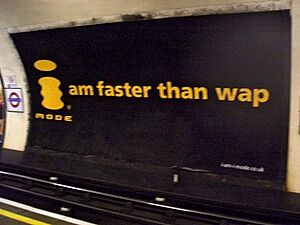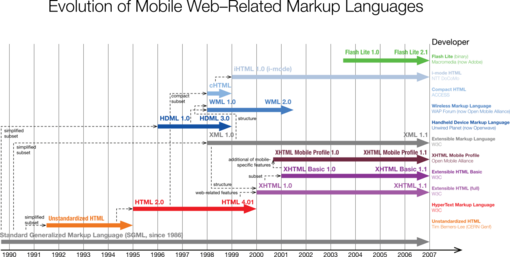- This page was last modified on 17 October 2025, at 10:18. Suggest an edit.
i-mode facts for kids
Not to be confused with Motorola's iDEN.

An i-mode advertisement in the London Underground
i-mode was a special way to get online using your mobile phone, mostly popular in Japan. It was created by a company called NTT DoCoMo. Unlike some other early mobile internet services, i-mode let people do many things online. This included checking websites, sending e-mail, and using a fast way to send data called a packet-switched network.
With i-mode, users could also check sports scores, get weather forecasts, play games, manage their money, and even book tickets. Special companies, often the phone company itself, provided this content. This helped them manage how people were charged for using these services.
Just like other early mobile internet services, i-mode only showed content that was specially made for it, or changed to fit its system.
What Was i-mode?
i-mode was different from another mobile internet standard called Wireless Application Protocol (WAP). WAP used a language called Wireless Markup Language (WML). But i-mode used a simpler version of HTML called C-HTML. HTML is the language used to build most websites you see on a computer.
C-HTML was made for small devices like early mobile phones. These phones didn't have much memory, powerful processors, or big color screens. They often had small, black-and-white displays and simple ways to type. Because of this, C-HTML couldn't show things like tables, fancy fonts, background colors, or complex designs.
i-mode phones had a special button to get to the main menu. There were over 12,000 official i-mode websites and many more unofficial ones. NTT DoCoMo checked the content of all official sites. Most of these were businesses. You could find official sites through DoCoMo's i-mode menu, or sometimes by typing in the website address (URL) or scanning a QR code.
When using i-mode, you paid for the data you sent and received. There were also ways to avoid unwanted emails, like spam. The basic monthly cost for i-mode was usually around 200-300 JPY, not including data charges. You could also pay extra for special services each month. There were discount plans too, like family discounts or plans for unlimited data transfer at a fixed monthly price (around ¥4,000).
How i-mode Started
i-mode first launched in Japan on February 22, 1999. Mari Matsunaga led the team that planned the content and service design. Takeshi Natsuno was in charge of growing the business. Keiichi Enoki, a top executive, looked after the technical side.
A few months after i-mode started, other phone companies in Japan launched similar services. KDDI started EZweb, and J-Phone launched J-Sky. Later, Vodafone bought J-Phone and changed J-Sky to Vodafone live!. Eventually, SoftBank bought Vodafone KK and renamed it SoftBank Mobile.
Some big companies like Bandai and Namco quickly made games and content for i-mode. Bandai launched "Dokodemo Aso Vegas" in May 1999, and it had over 1 million paying users by March 2000. Namco started "Namco Station" in December 1999.
i-mode was most popular in Japan around 2008. On October 29, 2019, DoCoMo announced that i-mode would stop working in March 2026.
i-mode Around the World
Because i-mode was so successful in Japan, many phone companies in Europe, Asia, and Australia wanted to offer it. Takeshi Natsuno helped i-mode expand to 17 countries worldwide.
i-mode quickly became popular in the countries where it launched. This led to even more phone companies wanting to offer it, reaching a total of 17 markets around the world.
While i-mode was a great service, another reason for its success was that Japanese smartphone makers created advanced phones that worked well with i-mode. However, when i-mode went to other countries, big phone makers like Nokia didn't want to make phones that supported i-mode at first. So, phone companies launching i-mode had to use Japanese phones, which were new to international markets.
Later, some phone makers started to make i-mode compatible phones, but it was often too late or only partly supported. Because of the lack of good phones and the rise of new internet services, i-mode never became as popular outside of Japan.
i-mode even sponsored the Renault F1 team from 2004 to 2006.
i-mode was launched in these countries:
- Australia (Telstra)
- Belgium (Base)
- Bulgaria (Globul)
- France (Bouygues Télécom)
- Germany (E-Plus)
- Greece (Cosmote)
- Hong Kong (3)
- Ireland (O2)
- Israel (Cellcom)
- Italy (Wind)
- Netherlands (KPN)
- Romania (Cosmote Romania)
- Russia (MTS)
- Singapore (StarHub)
- Spain (Telefónica)
- Taiwan (FarEasTone)
- UK (O2)
i-mode Phones
i-mode phones often had a "clamshell" design, meaning they folded in half. They usually had large screens (240 x 320 pixels) and sometimes a screen on the outside too. Many models also had extra features, like a megapixel digital camera. The screens typically showed 65,536 colors, but newer models could show up to 262,144 colors.
Here are some examples of i-mode phones:
- FOMA SA800i
- Fujitsu F905i (one of the few Japanese i-mode phones sold outside Japan)
- LG KE390i
- LG L342i
- LG L343i
- LG L852i (PRADA)
- Mitsubishi M342i
- Motorola RAZR V3xx with i-mode
- Motorola SLVR L6 i-mode
- Motorola SLVR L7 i-mode
- NEC N21i
- NEC N22i
- NEC N343i
- NEC 411i
- Nokia N70 i-mode
- Nokia N95i
- Nokia 6120 classic
- Nokia 6124 classic
- Samsung S400i
- Samsung S500i
- Samsung Z320i
- Sony Ericsson K550im
- Sony Ericsson K610im
See also
- Mobile browser
- Information appliance
- Smartphone
- Japanese mobile phone culture
- Mobile game

